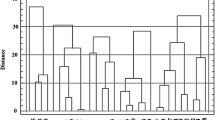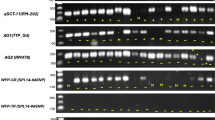Abstract
Phytic acid (PA) is considered as antinutrient in food and feed. Several low phytic acid (lpa) rice (Oryza sativa L.) mutants have been generated through induced mutation. Lpa mutant lines often exhibit inferior agronomic performance, and cross-breeding is applied to minimize these effects. The impact of such crossing steps on the PA contents in the resulting progenies is unknown. Therefore, three lpa rice mutants differing in mutation type were crossed with commercial rice cultivars, and PA contents in the progenies were determined for various generations grown at different locations. The PA contents of the lpa progenies were differently expressed for the investigated mutation-types and were dependent on environment and/or PA contents of the crossing parents. Nevertheless, for all three mutants, the homozygous lpa progenies always displayed significantly lower PA contents than the original wild-types subjected to the mutation. This demonstrated that cross-breeding of lpa rice mutants with commercial cultivars does not compromise the intended PA reduction and is a useful tool to obtain mutants stably expressing the intended lpa trait.



Similar content being viewed by others
References
Raboy V (2003) Myo-inositol-1,2,3,4,5,6-hexakisphosphate. Phytochemistry 64:1033–1043
Kumar V, Sinha AK, Makkar HPS, Becker K (2010) Dietary roles of phytate and phytase in human nutrition: a review. Food Chem 120:945–959
Humer E, Schwarz C, Schedle K (2015) Phytate in pig and poultry nutrition. J Anim Physiol Anim Nutr 99:605–625
Raboy V (2007) Seed phosphorus and the development of low-phytate crops. In: Turner B, RichardsonE LAE, Mullaney J (eds) Inositol phosphates: linking agriculture and the environment, 1st ed. CAB International, Wallingford, pp 111–132
Mendoza C, Viteri FE, Lonnerdal B, Young KA, Raboy V, Brown KH (1998) Effect of genetically modified, low-phytic acid maize on absorption of iron from tortillas. Am J Clin Nutr 68:1123–1127
Petry N, Egli I, Campion B, Nielsen E, Hurrell R (2013) Genetic reduction of phytate in common bean (Phaseolus vulgaris L.) seeds increases iron absorption in young women. J Nutr 143:1219–1224
Veum TL, Ledoux DR, Bollinger DW, Raboy V, Cook A (2002) Low-phytic acid barley improves calcium and phosphorus utilization and growth performance in growing pigs. J Anim Sci 80:2663–2670
Veum TL, Raboy V (2016) Hulled and hull-less barley grains with the genetic trait for low-phytic acid increased the apparent total-tract digestibility of phosphorus and calcium in diets for young swine. J Anim Sci 94:1000–1011
FAO (Food and Agriculture Organization of the United Nations) (2017) http://www.fao.org/faostat/en/#data/QC/visualize. Accessed 16 Dec 2017
Liu QL, Xu XH, Ren XL, Fu HW, Wu DX, Shu QY (2007) Generation and characterization of low phytic acid germplasm in rice (Oryza sativa L.). Theor Appl Genet 114:803–814
Zhao HJ, Liu QL, Fu HW, Xu XH, Wu DX, Shu QY (2008) Effect of non-lethal low phytic acid mutations on grain yield and seed viability in rice. Field Crops Res 108:206–211
Spear JD, Fehr WR (2007) Genetic improvement of seedling emergence of soybean lines with low phytate. Crop Sci 47:1354–1360
Averitt B, Shang C, Rosso L, Qin J, Zhang MC, Rainy KM, Zhang B (2017) Impact of mips1, lpa1, and lpa2 Alleles for low phytic acid content on agronomic, seed quality, and seed composition traits of soybean. Crop Sci 57:2490–2499
Wiggins SJ, Smallwood CJ, West DR, Kopsell DA, Sams CE, Pantalone VR (2018) Agronomic performance and seed inorganic phosphorus stability of low-phytate soybean line TN09-239. J Am Oil Chem Soc 95:787–796
Zhao HJ, Liu QL, Ren XL, Wu DX, Shu QY (2008) Gene identification and allele-specific marker development for two allelic low phytic acid mutations in rice (Oryza sativa L.). Mol Breed 22:603–612
Xu XH, Zhao HJ, Liu QL, Frank T, Engel KH, An GH, Shu QY (2009) Mutations of the multi-drug resistance-associated protein ABC transporter gene 5 result in reduction of phytic acid in rice seeds. Theor Appl Genet 119:75–83
Zhao HJ, Frank T, Tan YY, Zhou CG, Jabnoune M, Arpat AB, Cui HR, Huang JZ, He ZH, Poirier Y, Engel KH, Shu QY (2016) Disruption of OsSULTR3;3 reduces phytate and phosphorus concentrations and alters the metabolite profile in rice grains. New Phytol 211:926–939
Tan YY, Fu HW, Zhao HJ, Lu S, Fu JJ, Li YF, Cui HR, Shu QY (2013) Functional molecular markers and high-resolution melting curve analysis of low phytic acid mutations for marker-assisted selection in rice. Mol Breed 31:517–528
Oates K, De Borba B, Rohrer J (2014) Determination of inositol phosphates in dried distillers grains with solubles. Thermo Fisher Scientific, Sunnyvale, pp 1–10
Guideline IHT (2005) Validation of analytical procedures: text and methodology Q2 (R1). In: International conference on harmonization, Geneva, Switzerland, pp 11–12
Frank T, Habernegg R, Yuan FJ, Shu QY, Engel KH (2009) Assessment of the contents of phytic acid and divalent cations in low phytic acid (lpa) mutants of rice and soybean. J Food Compost Anal 22:278–284
Frank T, Meuleye BS, Miller A, Shu QY, Engel KH (2007) Metabolite profiling of two low phytic acid (lpa) rice mutants. J Agric Food Chem 55:11011–11019
Sparvoli F, Cominelli E (2015) Seed biofortification and phytic acid reduction: a conflict of interest for the plant? Plants 4:728–755
Sparvoli F, Cominelli E (2014) Phytate transport by MRPs. In: Plant Abc transporters, pp 19–38
Tong C, Chen YL, Tan YY, Liu L, Waters DLE, Rose TJ, Shu QY, Bao JS (2017) Analysis of lysophospholipid content in low phytate rice mutants. J Agric Food Chem 65:5435–5441
Stevenson-Paulik J, Bastidas RJ, Chiou ST, Frye RA, York JD (2005) Generation of phytate-free seeds in Arabidopsis through disruption of inositol polyphosphate kinases. Proc Natl Acad Sci USA 102:12612–12617
Vincent JA, Stacey M, Stacey G, Bilyeu KD (2015) Phytic acid and inorganic phosphate composition in soybean lines with independent IPK1 mutations. Plant Genome 8:1–10
Acknowledgements
This project was financially supported by the Sino-German Center for Research Promotion (project number GZ 932) and the China Scholarship Council (CSC).
Author information
Authors and Affiliations
Corresponding author
Ethics declarations
Conflict of interest
The authors declare no conflict of interest.
Compliance with ethics requirements
This article does not contain any studies with human or animal subjects.
Electronic supplementary material
Below is the link to the electronic supplementary material.
Rights and permissions
About this article
Cite this article
Zhou, C., Tan, Y., Goßner, S. et al. Impact of cross-breeding of low phytic acid rice (Oryza sativa L.) mutants with commercial cultivars on the phytic acid contents. Eur Food Res Technol 245, 707–716 (2019). https://doi.org/10.1007/s00217-018-3192-3
Received:
Revised:
Accepted:
Published:
Issue Date:
DOI: https://doi.org/10.1007/s00217-018-3192-3




